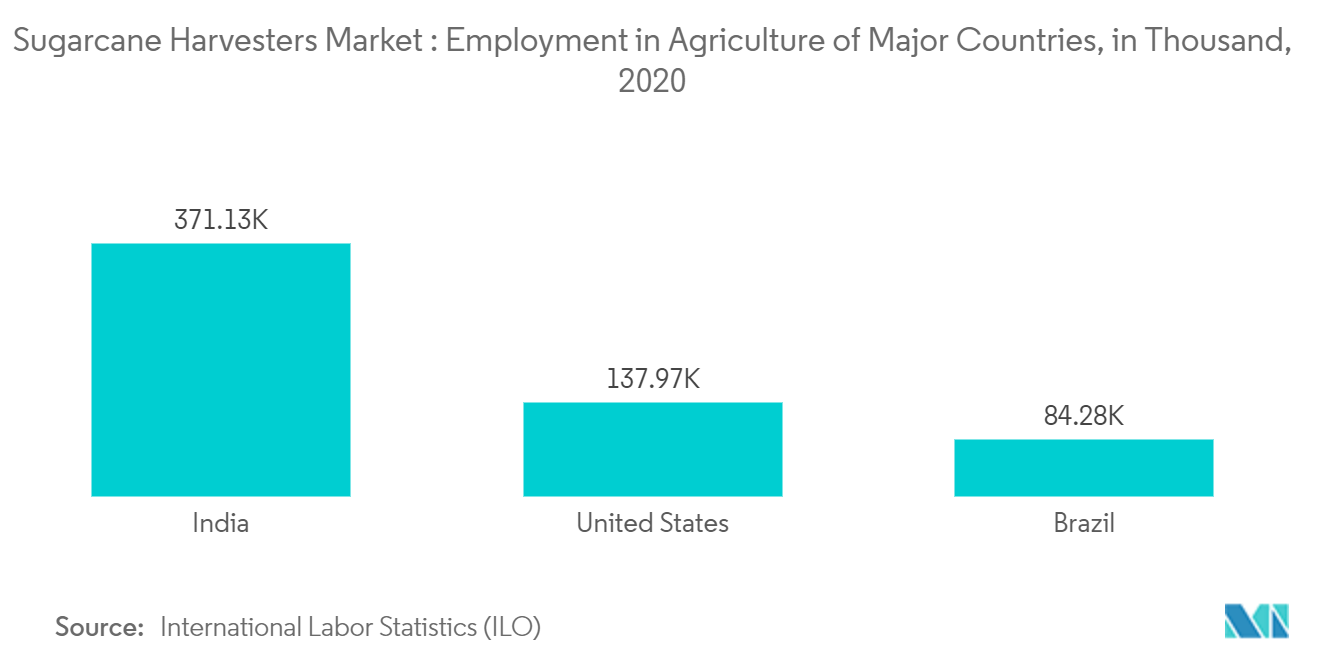Market Trends of Sugarcane Harvesters Industry
Decline in Farm Labor Driving the Market for Sugarcane Harvesters
- On average, developing economies have larger percentages of the population dependent on agriculture. However, the percentages have decreased over time as a large number of people migrate to urban areas every year. According to the Indian Council of Food and Agriculture (ICFA), the percentage of agriculture workers in India is estimated to decline by 25.7% in 2050. This has led to increasing demand for agricultural equipment in the country.
- The mechanization of the sugar cane sector, and in particular sugar cane harvesting, remains low across Southeast Asia relative to other major producing markets, namely Brazil and others in South America, India, and China. Due to decreasing agricultural labor, the prices of farm labor are rising.
- According to the United States Department of Agriculture (USDA) report, farm employment, which accounts for most agricultural employment, fell by 81%, and labor hours worked declined by 83% over the past decade. Farm labor declined as workers sought higher wages and other income opportunities in the non-farm sector.
- In addition, the transformation of the farm structure toward fewer and larger farms and the development of labor-saving technologies-such as bigger and faster tractors and combines and automated feeding equipment-reduced demand for farm workers. Total hours worked continued to decline in the last decade of the study, though more slowly than in previous decades. This resulted in an increase in demand for agricultural machinery such as sugar harvesters and is expected to grow further during the forecast period. Thus, sugarcane harvesters are the perfect solutions for farmers, saving time and money and improving their productivity.

Asia-Pacific is the Fastest-growing Market
- The Asia-Pacific region is expected to be the fastest-growing market, with India being the dominant market in this region. The driving factor, which influenced the market's growth, is technological innovations with respect to the specific needs of Indian farmers. The decline in the agriculture workforce in countries such as India and China is making farmers highly dependent on farming machinery, especially in post-harvesting activities.
- The supportive environment in terms of subsidies by various government policies is encouraging farmers to purchase farming machinery, and the demand is projected to grow further during the forecast period. Thailand is a key opportunity market for the mechanization of sugarcane harvesting, with Thailand being one of the largest producers of sugar cane globally, behind Brazil and India.
- In recent years, laborer scarcity and high wage rates highly affected the harvesting of crops in time. Owing to the issues of labor shortage, the Government of India provided machinery to the farmers with subsidies and allowed the usage considering all the safety features. For instance, in February 2023, Sanjivani sugar factory at Dayanandnagar-Tisk in Dharbandora, Goa. The machine is said to be in good condition and began working after nominal servicing involving changing its battery and oiling some parts. After it became operational, the machine harvested about 300 metric tonnes of canes cultivated within the farm of the factory. The factory had been using teams from neighboring states to harvest canes produced across the state. The government, through the factory, bears the cost of harvesting. To save time, the factory procured the machine
- Additionally, in October 2021, cane sugar production in China was estimated at 9.25 million metric tons, up 450,000 metric tons from the previous year's newly revised estimate but still slightly lower pre-drought levels. This predicted increase was mainly due to the expected return of normal weather conditions as well as stable sugarcane prices.
- The anticipated improvement in weather conditions, stable sugar cane prices, and government support are expected to enhance the market's growth in the coming years.


